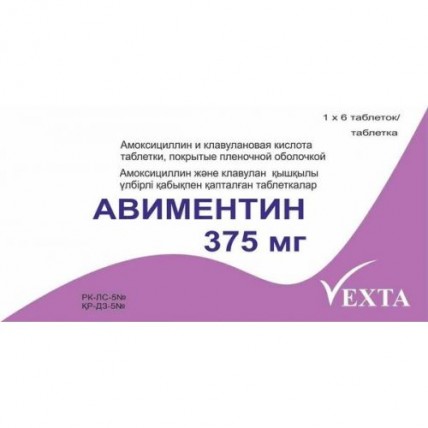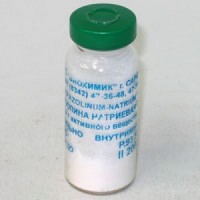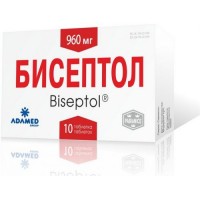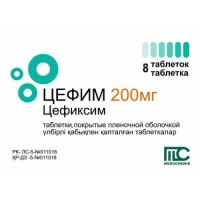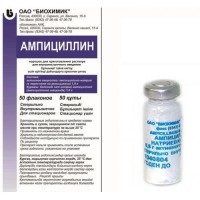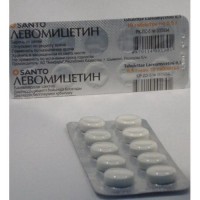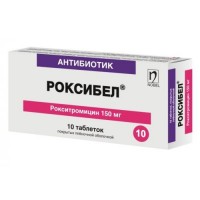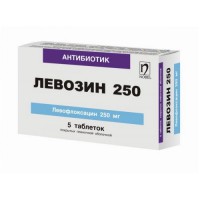The instruction for medical use of Avimentin Torgovoye medicine a name Avimentin Mezhdunarodnoye the unlicensed name Is not present the Dosage form of the Tablet, film coated, 375 mg (250 mg / 125 mg), 625 mg (500 mg / 125 mg), 1000 mg (825 mg / 125 mg) Structure One tablet contains active agents: Amoxicillin of trihydrate it is equivalent to amoxicillin of 250 mg, 500 mg, 875 mg, Diluted potassium of clavulanate it is equivalent to clavulanic acid of 125 mg, excipients: microcrystalline cellulose, sodium of starch glikolit, silicon dioxide colloidal, povidone, magnesium stearate, isopropyl alcohol structure of a cover: Opadry White® (a gipromelloza, the titan dioxide (E 171), a macrogoal, talc), polyethyleneglycol, methylene dichloride the Description of the Tablet, film coated white or almost white color, an oval form, biconvex, smooth on both sides (for a dosage of 375 mg and 625 mg). Tablets, film coated white or almost white color, an oval form, biconvex, with the line of a break on one party and smooth on the other hand (for a dosage of 1000 mg). Pharmacotherapeutic group Antibacterial drugs for system use. Penicillin in a combination with inhibitors beta laktamaz. Clavulanic acid + amoxicillin. The ATX J01CR02 code the Pharmacological Pharmacokinetics Absorption Amoxicillin properties and clavulanic acid are completely dissolved in aqueous solutions at a physiological rn. Both components are quickly and well soaked up from digestive tract after oral administration. Absorption of amoxicillin / clavulanic acid is optimum in case of administration of drug at the beginning of food. After administration of drug in its bioaccess makes 70%. Profiles of both components of drug are similar and reach peak concentration in plasma (T max.) approximately in one hour. Concentration of amoxicillin and clavulanic acid in blood serum is identical as in case of combined use of amoxicillin and clavulanic acid, and each component separately. Distribution Linking of amoxicillin and clavulanic acid with proteins of plasma moderate: 25% for clavulanic acid and 18% for amoxicillin. The visible volume of distribution is about 0.3-0.4 l/kg for amoxicillin and about 0.2 l/kg for clavulanic acid. Amoxicillin and clavulanic acid practically do not get into cerebrospinal fluid. Amoxicillin, as well as the majority of penicillin, is emitted with breast milk. In breast milk also trace amounts of clavulanic acid can be found. Except for risk of a sensitization, amoxicillin and clavulanic acid has no negative impact on health of the babies raised by breast milk. Metabolism Amoxicillin is partially allocated from mochy in the form of inactive penicillic acid in the quantity equivalent to 10-25% of the accepted dose. Clavulanic acid is exposed to intensive metabolism and is emitted from mochy and a stake and also in the form of carbon dioxide through expired air. Removal Amoxicillin is removed, generally by kidneys whereas clavulanic acid - by means of both renal, and extrarenal mechanisms. After single dose in one tablet of 250 mg / 125 mg or 500 mg / 125 mg about 60-70% of amoxicillin and 40-65% of clavulanic acid during the first 6 h. It is removed from mochy in not changed look. A pharmacodynamics the action Mechanism Amoxicillin - the semi-synthetic antibiotic of a broad spectrum of activity having activity against many gram-positive and gram-negative microorganisms. At the same time amoxicillin is subject to destruction by beta lactamelements and therefore the range of activity of amoxicillin does not extend to microorganisms which produce these enzymes. Clavulanic acid - inhibitor beta laktamaz, structurally related to penicillin, has ability to inactivate a wide range beta laktamaz, found in the microorganisms resistant to penicillin and cephalosporins. Clavulanic acid has sufficient efficiency concerning plasmid beta laktamaz most of which often cause resistance of bacteria, and is less effective concerning chromosomal beta laktamaz 1 type. Presence of clavulanic acid at the drug Avimentin protects amoxicillin from destruction by enzymes - beta lactamelements that allows to expand an antibacterial range of amoxicillin. The activity of a combination of amoxicillin with in vitro clavulanic acid is given below. The bacteria usually sensitive to an amoxicillin combination with clavulanic acid Gram-positive aerobes of Bacillus anthracis Enterococcus faecalis Gardnerella vaginalis Listeria monocytogenes Nocardia asteroides Streptococcus pneumoniae1.2 Streptococcus pyogenes1.2 Streptococcus agalactiae1.2 Streptococci of the Viridans2 Streptococcus spp group. (other beta and hemolytic streptococci) 1.2 Staphylococcus aureus (sensitive to Methicillinum) 1 * Staphylococcus saprophytics (sensitive to Methicillinum) Koagulazonegativnye staphylococcus (sensitive to Methicillinum) Gram-positive anaerobe bacterias of Clostridium spp. Peptococcus niger Peptostreptococcus magrtus Peptostreptococcus micros Peptostreptococcus spp. Gram-negative aerobes of Bordetella pertussis Haemophilus influenzae1 Helicobacter pylori Moraxella catarrhal Neisseria gonorrhoeae Pasteurella multocida Vibrio cholerae Gram-negative anaerobe bacterias of Bacteroides fragilis Bacteroides spp. Capnocytophaga spp. Eikenella corrodens Fusobacterium nucleatum Fusobacterium spp. Porphyromonas spp. Prevotella spp. Other Borrelia burgdorferi Leptospira icterohaemorrhagiae Treponema pallidum of the Bacterium for which the acquired resistance to an amoxicillin combination with clavulanic acid Gram-negative aerobes of Escherichia coli1 Klebsiella oxytoca Klebsiella pneumoniae1 Klebsiella spp is probable. Proteus mirabilis Proteus vulgaris Proteus spp. Salmonella spp. Shigella spp. Gram-positive aerobes of Corynebacterium spp. Enterococcus faecium of the Bacterium having natural resistance to an amoxicillin combination with clavulanic acid Gram-negative aerobes of Acinetobacter spp. Citrobacter freundii Enterobacter spp. Hafnia alvei Legionella pneumophila Morganella morganii Providencia spp. Pseudomonas spp. Serratia spp. Stenotrophomonas maltophilia Yersinia enterocolitica Other Chlamydia pneumoniae Chlamydia psittaci Chlamydia spp. Coxiella burnetii Mycoplasma spp. 1 - for these bacteria the clinical performance of a combination of amoxicillin with clavulanic acid was shown in clinical trials. 2 - strains of these species of bacteria do not produce beta lactamelements. The sensitivity at monotherapy by amoxicillin allows to assume similar sensitivity to an amoxicillin combination with clavulanic acid. * - certain representatives of the specified genus of microorganisms, produce β-lactamazu that does them insensitive to amoxicillin. Indications the Bacterial infections caused by microorganisms, sensitive to drug: - upper respiratory tract infection and ENT organs: recurrent tonsillitis, sinusitis, average otitis - infections of lower parts of airways: exacerbations of chronic bronchitis, community-acquired pneumonia, bronchial pneumonia - infections of an urinogenital path: cystitis, pyelonephritis - infections of skin and soft tissues - infections of bones and joints, in particular osteomyelitis the Route of administration and doses the Mode of dosing is set individually depending on age, body weight, function of kidneys of the patient and also from severity of an infection. For optimum absorption and reduction of possible side effects from digestive system Avimentin is recommended to accept at the beginning of food. The minimum course of antibacterial therapy makes 5 days. Treatment should not continue more than 14 days without revision of a clinical situation. If necessary performing step therapy is possible (at the beginning of therapy parenteral administration of drug with the subsequent transition to oral administration). Adults and children are more senior than 12 years or with the body weight of 40 kg and more On 1 tablet of 250 mg / 125 mg of 3 times/days (in infections easy and moderate severity), or on 1 tablet of 500 mg / 125 mg of 3 times/days, or on 1 tablet of 875 mg / 125 mg of 2 times/days, or on 11 ml of suspension of 400 mg / 57 mg / 5 ml of 2 times/days (that is equivalent to 1 tablet of 875 mg / 125 to mg). 2 tablets of 250 mg / 125 to mg are not equivalent to 1 tablet of 500 mg / 125 to mg. Low doses of the drug Avimentin are applied to treatment of infections of skin and soft tissues and also recurrent tonsillitis. High doses of drug of Avimentin are applied to treatment of such diseases as average otitis, sinusitis, lower respiratory tract infections and urinary tract, an infection of bones and joints. Premature children Are not present recommendations concerning the dosing mode. Patients of advanced age drug dose adjustment is not required. At elderly patients with renal failures the dose should be adjusted as it is specified for adults with renal failures. Patients with a renal failure the Regulation of a dose is not required from patients with clearance of creatinine more, than 30 ml/min. Patients with clearance of creatinine have less than 30 ml/min., drug use amoxicillin with clavulanic acid in the ratio 2:1 is not recommended as there are no recommendations for dose adjustment. The renal failure Adjustment of a dose is not required from patients with the clearance of creatinine (CC) more, than 30 ml/min. Adults and children ≥ 40 kg of KK: 10-30 ml/min. 250 mg / 125 mg twice a day KK & lt, 10 ml/min. 250 mg / 125 mg once a day the Hemodialysis Two doses of 250 mg / 125 mg each 24 hours, plus two doses of 250 mg / 125 mg during dialysis, it is necessary to repeat at the end of dialysis (as concentration in serum of both drugs, decrease) Children & lt, children have 40 kg & lt, 40 kg with clearance of creatinine less than 30 ml/min., use of amoxicillin with clavulanic acid in the ratio 2: 1 it is not recommended. At such patients drugs about amoxicillin with clavulanic acid 4:1 is recommended. Patients with abnormal liver functions carry out Treatment with care, regularly carry out monitoring of function of a liver. There are not enough data for carrying out correction of the mode of dosing at this category of patients. Side effects the Undesirable phenomena given below are listed according to defeat of bodies and the systems of bodies and occurrence frequency. Frequency of occurrence is defined as follows: very often (≥1/10), it is frequent (≥1/100, & lt, 1/10), infrequently (≥1/1000, & lt, 1/100), is rare (≥1/10,000, & lt, 1/1000), is very rare (& lt, 1/10,000). Categories of frequency were created on the basis of clinical trials of drug and post-registration observation. Often: - candidiasis of skin and mucous covers - nausea, vomiting, diarrhea Nausea meets at use of high doses of drug more often. For decrease in extent of manifestation it is recommended to take the drug at the beginning of meal. Infrequently: - dizziness, a headache - dyspepsia - moderate increase in level of liver enzymes of ALT/nuclear heating plant (it is observed at the patients receiving therapy beta laktamnymi antibiotics, however its clinical importance is unknown) - skin rash, an itching, a small tortoiseshell Seldom: - a reversible leukopenia (including a neutropenia), thrombocytopenia - a multiformny erythema It is unknown: - a reversible agranulocytosis and hemolytic anemia, increase in a bleeding time and the index of a prothrombin time - a Quincke's disease, an anaphylaxis, the syndrome similar to a serum disease, an allergic vasculitis - reversible superactivity and spasms - the antibiotiko-associated colitis (including pseudomembranous and hemorrhagic) - black hairy language (chronic hyperplasia of threadlike nipples of language) - hepatitis, cholestatic jaundice - the overgrowth of insensitive microflora - Stephens-Johnson's syndrome, a toxic epidermal necrolysis, bullous exfoliative dermatitis, sharp generalized exanthematous pustulyoz, aseptic meningitis. At development of these symptoms, drug needs to be cancelled urgently. - interstitial nephrite, a crystalluria the Listed signs and symptoms usually meet in process or at once upon termination of therapy, however in some cases can not be shown within several weeks after completion of therapy. The undesirable phenomena, as a rule, are reversible. Oral cavity care helps to prevent change of coloring of adamantine substance of tooth as for this purpose it is enough to brush teeth. The undesirable phenomena from a liver can be heavy, in exclusively exceptional cases there were messages about lethal outcomes. Almost in all cases it were persons with the serious accompanying pathology or the persons receiving at the same time potentially gepatotoksichny drugs. Messages about expected side reactions Providing data on expected side reactions of drug is very important point allowing to carry out continuous monitoring of a ratio risk/advantage of medicine. Health workers should provide information on any expected adverse reactions on the contacts specified at the end of the instruction and also through the national system of collection of information. Contraindications — hypersensitivity to amoxicillin, clavulanic acid, other components of drug, beta laktamnym to antibiotics (for example, penicillin, cephalosporins) in the anamnesis — the previous episodes of jaundice or an abnormal liver function at use of a combination of amoxicillin with clavulanic acid in the anamnesis — children's age up to 12 years and body weight less than 40 kg (for tablets of 250 mg / 125 mg or 500 mg / 125 mg, or 875 mg / 125 mg) — a renal failure (KK ≤ 30 ml/min.) - (for tablets of 875 mg / 125 mg), With care: abnormal liver functions. Medicinal interactions Simultaneous use of the drug Avimentin and a probenetsid is not recommended. Probenetsid reduces canalicular secretion of amoxicillin and therefore simultaneous use of the drug Avimentin and a probenetsid can lead to increase and a persistention in blood of concentration of amoxicillin, but not clavulanic acid. Simultaneous use of Allopyrinolum and amoxicillin can increase risk of emergence of skin allergic reactions. Now in literature there are no data on simultaneous use of a combination of amoxicillin with clavulanic acid and Allopyrinolum. Penicillin is capable to slow down removal from a methotrexate organism at the expense of inhibition of its canalicular secretion therefore, simultaneous use of the drug Avimentin and a methotrexate can increase toxicity of a methotrexate. As well as other antibacterial drugs, the drug Avimentin can influence intestinal microflora, leading to decrease in absorption of estrogen from a GIT and to decrease in efficiency of the combined oral contraceptives. In literature exceptional cases of increase in MHO at patients at combined use of an atsenokumarol or warfarin and amoxicillin are described. In need of co-administration of drug of Avimentin with anticoagulants the prothrombin time and MHO have to be controlled carefully, during the assigning or drug withdrawal Avimentin is required dose adjustment of anticoagulants for intake. Special instructions Before an initiation of treatment the drug Avimentin need to be collected the detailed anamnesis concerning the previous reactions of hypersensitivity to penicillin, cephalosporins or other allergens. Reactions of hypersensitivity (anaphylactic reactions) to penicillin are described serious, and sometimes and lethal. The risk of emergence of such reactions is highest at the patients having in the anamnesis of reaction of hypersensitivity to penicillin. In case of allergic reaction it is necessary to stop the Avimentin drug treatment and to begin the corresponding alternative therapy. At serious reactions of hypersensitivity it is necessary to enter epinephrine immediately. Can be required also oxygenotherapy, in/in the introduction of GKS and ensuring passability of airways including an intubation. Prescribing of the drug Avimentin at suspicion of an infectious mononucleosis as with this disease amoxicillin can cause korepodobny rash in patients that complicates diagnosis of a disease is not recommended. Long-term treatment by the drug Avimentin sometimes leads to excessive reproduction of insensitive microorganisms. In general, the prepa
at Avimentin is transferred well and has hypotoxicity inherent to all penicillin. During long therapy the drug Avimentin recommends to estimate periodically function of kidneys, liver and hemopoiesis. For the purpose of reduction of risk of development of side effects from a GIT it is necessary to take the drug at the beginning of meal. At patients with a renal failure the dose of the drug Avimentin should be reduced according to extent of disturbance. Appearance of spasms in patients with a renal failure or receiving high doses of drug is possible. At patients with a reduced diuresis it was seldom or never reported about development of a crystalluria, mainly at parenteral use of drug. During introduction of high doses of amoxicillin it is recommended to accept enough liquid and to support an adequate diuresis for reduction of probability of formation of crystals of amoxicillin. Avimentin inside leads administration of drug to the high content of amoxicillin in urine that can result in false positive results when determining glucose in urine (for example, Benedict's test, test of Felinga). In this case it is recommended to apply a glyukozoksidantny method of definition of concentration of glucose in urine. Oral cavity care helps to prevent change of coloring of teeth as for this purpose it is enough to brush teeth. Tablets need to be used within 30 days from the moment of packing opening. Abuse and medicinal dependence was not observed the medicinal dependence, accustoming and reactions of euphoria connected with the drug Avimentin use. Pregnancy and the period of a lactation Use of the drug Avimentin is not recommended during pregnancy unless the expected advantage of use for mother exceeds potential risk for a fruit. The drug Avimentin gets into breast milk, use is possible during breastfeeding, after assessment advantage/risk. Development of diarrhea and/or candidiasis of mucous membranes of an oral cavity and a sensitization is possible. In case of adverse effects at the babies who are on breastfeeding it is necessary to stop breastfeeding. Use in abnormal liver functions Treatment is carried out with care, regularly carry out monitoring of function of a liver. There are not enough data for carrying out correction of the mode of dosing at this category of patients. Use in renal failures the Dose of drug has to be corrected depending on extent of disturbance. Use for children Children is younger than 12 years Drug appoint in the form of suspension for intake. Calculation of a dose is made depending on age and weight, specified in body weight mg/kg a day (calculation for amoxicillin) or in suspension milliliters. Children with the body weight of 40 kg and more should appoint the same doses, as well as the adult. Low doses of the drug Avimentin are applied to treatment of infections of skin and soft tissues and also recurrent tonsillitis. High doses of the drug Avimentin are applied to treatment of such diseases as average otitis, sinusitis, lower respiratory tract infections and urinary tract. Use for elderly patients a dose decline of Avimentin is not required to Elderly patients, doses same, as for adults. At elderly patients with renal failures the dose should be adjusted as for adults with renal failures. Features of influence of medicine on ability to run the vehicle or potentially dangerous mechanisms As drug can cause dizziness, it is necessary to warn patients about precautionary measures during the driving or work with moving mechanisms. Overdose Symptoms: there can be symptoms from a GIT and disturbance of water and electrolytic balance. The amoksitsillinovy crystalluria in certain cases leading to development of a renal failure is described. Spasms at patients with renal failures and also at those who receive high doses of drug can be observed. Treatment: symptoms from a GIT - symptomatic therapy, paying special attention to normalization of water and electrolytic balance. In case of overdose, amoxicillin and clavulanic acid can be removed from a blood-groove by a hemodialysis. The form of release and packing On 6 (for dosages of 375 mg and 1000 mg) or on 10 (for a dosage of 625 mg) tablets place in blister strip packaging from aluminum foil. On 1 blister strip packaging (for a dosage of 375 mg) or on 2 blister strip packagings (for dosages of 625 mg and 1000 mg) together with the instruction for medical use in the state and Russian languages place in a pack from cardboard. Storage conditions In the dry, protected from light place, at a temperature not over 25 ºС. To store out of children's reach. 2 years not to apply a period of storage after an expiration date. Prescription status According to the prescription Vexta Laboratories Pvt Producer. Ltd. Office 20 & 21 A, A.K. Vaidya Marg, Goregaon (E), Mumbai 400063, India Owner of the registration certificate of Avitsena-Ltd LLP, Kazakhstan 050002, Almaty, Dzhangildin St., 31, office 416 Name and country of the Veksta Laboratoriyes Pvt organization packer. Ltd., India of the accepting claim (offer) from consumers on quality of medicine of Avitsena-LTD LLP 050002, Almaty, Dzhangildin St., 31, office 416 the Address of the organization responsible for post-registration observation of safety of medicine of ConsultAsia LLP
to Develop the Address of the organization in the territory of the Republic of Kazakhstan
at Avimentin is transferred well and has hypotoxicity inherent to all penicillin. During long therapy the drug Avimentin recommends to estimate periodically function of kidneys, liver and hemopoiesis. For the purpose of reduction of risk of development of side effects from a GIT it is necessary to take the drug at the beginning of meal. At patients with a renal failure the dose of the drug Avimentin should be reduced according to extent of disturbance. Appearance of spasms in patients with a renal failure or receiving high doses of drug is possible. At patients with a reduced diuresis it was seldom or never reported about development of a crystalluria, mainly at parenteral use of drug. During introduction of high doses of amoxicillin it is recommended to accept enough liquid and to support an adequate diuresis for reduction of probability of formation of crystals of amoxicillin. Avimentin inside leads administration of drug to the high content of amoxicillin in urine that can result in false positive results when determining glucose in urine (for example, Benedict's test, test of Felinga). In this case it is recommended to apply a glyukozoksidantny method of definition of concentration of glucose in urine. Oral cavity care helps to prevent change of coloring of teeth as for this purpose it is enough to brush teeth. Tablets need to be used within 30 days from the moment of packing opening. Abuse and medicinal dependence was not observed the medicinal dependence, accustoming and reactions of euphoria connected with the drug Avimentin use. Pregnancy and the period of a lactation Use of the drug Avimentin is not recommended during pregnancy unless the expected advantage of use for mother exceeds potential risk for a fruit. The drug Avimentin gets into breast milk, use is possible during breastfeeding, after assessment advantage/risk. Development of diarrhea and/or candidiasis of mucous membranes of an oral cavity and a sensitization is possible. In case of adverse effects at the babies who are on breastfeeding it is necessary to stop breastfeeding. Use in abnormal liver functions Treatment is carried out with care, regularly carry out monitoring of function of a liver. There are not enough data for carrying out correction of the mode of dosing at this category of patients. Use in renal failures the Dose of drug has to be corrected depending on extent of disturbance. Use for children Children is younger than 12 years Drug appoint in the form of suspension for intake. Calculation of a dose is made depending on age and weight, specified in body weight mg/kg a day (calculation for amoxicillin) or in suspension milliliters. Children with the body weight of 40 kg and more should appoint the same doses, as well as the adult. Low doses of the drug Avimentin are applied to treatment of infections of skin and soft tissues and also recurrent tonsillitis. High doses of the drug Avimentin are applied to treatment of such diseases as average otitis, sinusitis, lower respiratory tract infections and urinary tract. Use for elderly patients a dose decline of Avimentin is not required to Elderly patients, doses same, as for adults. At elderly patients with renal failures the dose should be adjusted as for adults with renal failures. Features of influence of medicine on ability to run the vehicle or potentially dangerous mechanisms As drug can cause dizziness, it is necessary to warn patients about precautionary measures during the driving or work with moving mechanisms. Overdose Symptoms: there can be symptoms from a GIT and disturbance of water and electrolytic balance. The amoksitsillinovy crystalluria in certain cases leading to development of a renal failure is described. Spasms at patients with renal failures and also at those who receive high doses of drug can be observed. Treatment: symptoms from a GIT - symptomatic therapy, paying special attention to normalization of water and electrolytic balance. In case of overdose, amoxicillin and clavulanic acid can be removed from a blood-groove by a hemodialysis. The form of release and packing On 6 (for dosages of 375 mg and 1000 mg) or on 10 (for a dosage of 625 mg) tablets place in blister strip packaging from aluminum foil. On 1 blister strip packaging (for a dosage of 375 mg) or on 2 blister strip packagings (for dosages of 625 mg and 1000 mg) together with the instruction for medical use in the state and Russian languages place in a pack from cardboard. Storage conditions In the dry, protected from light place, at a temperature not over 25 ºС. To store out of children's reach. 2 years not to apply a period of storage after an expiration date. Prescription status According to the prescription Vexta Laboratories Pvt Producer. Ltd. Office 20 & 21 A, A.K. Vaidya Marg, Goregaon (E), Mumbai 400063, India Owner of the registration certificate of Avitsena-Ltd LLP, Kazakhstan 050002, Almaty, Dzhangildin St., 31, office 416 Name and country of the Veksta Laboratoriyes Pvt organization packer. Ltd., India of the accepting claim (offer) from consumers on quality of medicine of Avitsena-LTD LLP 050002, Almaty, Dzhangildin St., 31, office 416 the Address of the organization responsible for post-registration observation of safety of medicine of ConsultAsia LLP
to Develop the Address of the organization in the territory of the Republic of Kazakhstan
